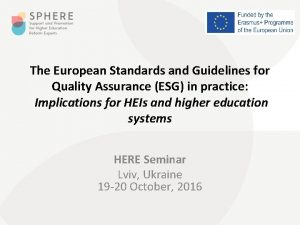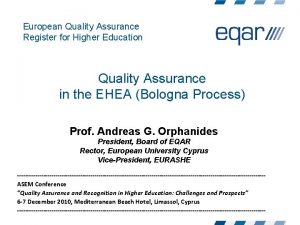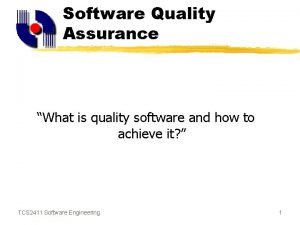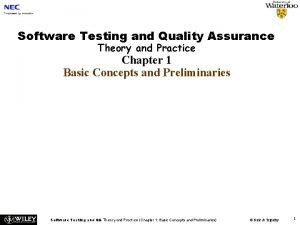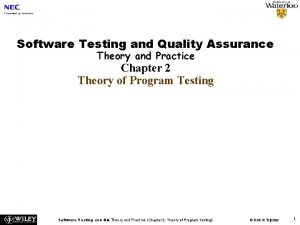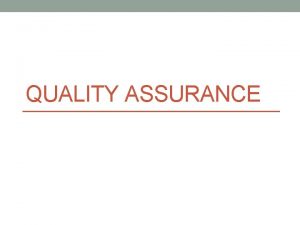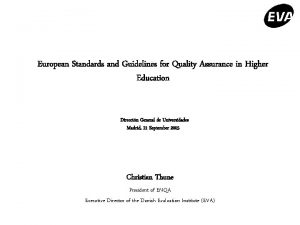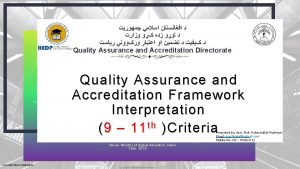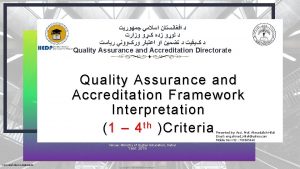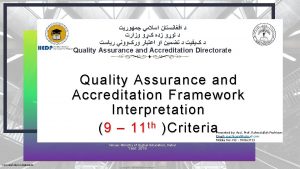The European Standards and Guidelines for Quality Assurance












- Slides: 12

The European Standards and Guidelines for Quality Assurance (ESG) in practice: Implications for HEIs and higher education systems Some conclusions HERE Seminar Lviv, Ukraine 19 -20 October, 2016

Desired Learning Outcomes • Generate awareness for the ESG 2015, what they consist of, how they have been built and endorsed and how they are being implemented in different European countries • Discuss and debate in particular the institutional responsibility for QA and the need to build capacity for this • Learn about the conditions for building dynamic QA systems that take into account national and regional needs and interests, as well as the changing HE landscape

Which of the below issues are important for you to explore? Relationship of QA, rankings and other ‘transparency tools’, 14 Different types of external QA- benefits and drawbacks, 11 QA and joint degrees, 8 Building institutional quality culture, 18 International/Regional collaboration in QA, 13 Building a quality assurance unit in my HEI, 5 Involving students in QA, 15 QA and e-learning, 5 -build institutional quality culture -the involvement of students in QA -the relationship of QA, ranking and other ‘transparency tools’ -international/regional collaboration in QA Data collection for QA, 9

Are you aware of the revised ESG and what is new about them? 26% Yes No 74% 4 respondents could describe what was new about them…. .

Core features of the ESG? • • • Diversity of systems - 2 Students, stakeholders, society - 2 Student-centred learning - 5 Transparency and mutual understanding – 3 Internal - external QA: University and ministry/agency - 7 Changing the culture of education in universities/quality culture Autonomy Fit for purpose Other terms mentioned: Difference between QA and ranking Compliance

Shared difficulties • Involving students in QA systematically • Linking QA to the development of LO based approaches • Building capacity of institutions to implement their own QA processes

Student involvement • Student satisfaction surveys versus participation in working bodies and committees – How to innovate? • Student representative bodies: independence, representative legitimacy, outreach and communications • How to generate student interest in QA? – UEF example of QMS course for credit, participating in audits linked to professional development • Student participation in evaluation panels – How to introduce? Delicate political and cultural climate? Possibilities through international projects? – UEF example of students in management review meetings

Institutions’ QA processes • Start from your own institutional strategy…QA should be fit for purpose • Strategic leadership, support, training • Resourcing QA

Internationalisation of QA • Is the QA problem local, regional or internationaland…. . solve problem at appropriate level • Practice sharing projects for internal QA management • Importance of QA networks (Central Asian example) • ‘internationalisation of QA’ if not just about agencies but about institutions as well – Sharing of international peers in evaluation teams – Generally enhances international reputation and attractiveness (for students) if international evaluation done

Internationalisation of QA • Distance learning – Can the same EQA and IQA be applied… ESG say yes – Distance learning and joint programmes more challenging than e-learning as such (as a pedagogical tool) regarding QA • Cross-border HE – You operate abroad – International institutions operate in your country

Issues to further explore • QA versus Rankings – Relevance of ranking for QA? How can rankings be used? • More support for institutional capacity building- Potential study visit? • Good practice in evaluation SCL • Facilitating the inclusion of international peers into evaluation teams

SPHERE Contacts • • • Elizabeth Colucci: elizabeth. colucci@eua. be Nicolas Patrici: npatrici@obreal. org General queries: here@ub. edu
 European standards and guidelines for quality assurance
European standards and guidelines for quality assurance European quality assurance standards
European quality assurance standards European quality assurance agency
European quality assurance agency Quality assurance vs quality control
Quality assurance vs quality control Basic concepts of quality assurance
Basic concepts of quality assurance Iso 9001 software quality assurance
Iso 9001 software quality assurance Pmp quality vs grade
Pmp quality vs grade Pmp gold plating
Pmp gold plating Quality assurance model in nursing management
Quality assurance model in nursing management Quality improvement vs quality assurance
Quality improvement vs quality assurance Quality assurance theory
Quality assurance theory Software testing and quality assurance: theory and practice
Software testing and quality assurance: theory and practice Software testing and quality assurance theory and practice
Software testing and quality assurance theory and practice
